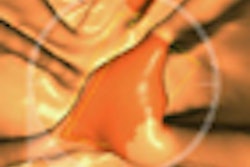As many as one in five patients being treated for peripheral arterial disease have concurrent -- but silent -- asymptomatic coronary artery disease that's severe enough to require invasive procedures, according to a study presented at the RSNA meeting earlier this month.
Physicians used CT angiography and MRI to check on the coronary arteries of patients in the proposed controlled study -- but when it became apparent that many patients in the intervention group were exhibiting severe coronary anatomy, the trial was stopped and all patients with peripheral arterial disease were offered cardiac imaging.
"Peripheral arterial disease patients are known to be at increased risk of mortality due to heart disease, and our results confirm the importance of strict cardiovascular risk factor treatment in these patients," said Dr. Rozemarijn Vliegenthart Proenca, Ph.D., a resident radiologist at the University Medical Center Groningen in the Netherlands.
She suggested that patients diagnosed with peripheral arterial disease might need evaluation of their coronary arteries during a press briefing at the RSNA conference.
Although the patients in the study had been diagnosed with peripheral arterial disease, they did not complain of coronary artery disease symptoms, such as chest pain or shortness of breath, despite the fact that 19% of the patients in the trial were found to have narrowed coronary arteries.
Vliegenthart Proenca and colleagues from four centers in the Netherlands enrolled 231 patients who had peripheral arterial disease but no symptomatic coronary artery disease or family history of heart disease.
A total of 115 patients underwent imaging and 116 served as controls, receiving standard care, which included medication or invasive treatment for leg artery narrowing. The trial was truncated early after initial results showed that withholding imaging studies from the control patients could not be defended ethically, Vliegenthart Proenca said.
Patients received CT angiography and then MRI to evaluate heart function three weeks later. The researchers found that 46% of patients had at least one significant narrowing in a coronary artery. About a fifth -- 19% -- had severe coronary artery disease detected at CT angiography.
All patients with positive findings were referred to a cardiologist. Subsequently, 20 patients underwent conventional invasive coronary angiography, eight had bypass surgery, three received stents, and eight were put on medication, according to Vliegenthart Proenca.
She explained that little is known about silent heart disease in patients with leg artery narrowing. However, new technologies such as CT angiography have made it easier to detect the extent of coronary artery disease in a noninvasive manner.
Invasive tests such as coronary angiography are less likely to be performed in patients who don't have symptoms of heart disease because of a potential risk of complications, she added.
"Possibly, screening for silent coronary artery disease in peripheral arterial disease patients by using noninvasive methods, combined with treatment of narrowing in coronary arteries, may improve the survival of these patients," she said.
Still, additional studies are needed to evaluate whether screening for silent heart disease in peripheral arterial disease patients actually results in better survival, she said.
By Ed Susman
AuntMinnie.com contributing writer
December 30, 2009
Related Reading
DECT beats manual bone subtraction in peripheral artery disease, November 16, 2009
CE-MRA helps plan treatment of patients with peripheral artery issues, November 10, 2009
CTA shows best approach to blocked leg arteries, June 5, 2009
Copyright © 2009 AuntMinnie.com


















